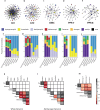Metabolic interactions underpinning high methane fluxes across terrestrial freshwater wetlands
- PMID: 39843444
- PMCID: PMC11754854
- DOI: 10.1038/s41467-025-56133-0
Metabolic interactions underpinning high methane fluxes across terrestrial freshwater wetlands
Abstract
Current estimates of wetland contributions to the global methane budget carry high uncertainty, particularly in accurately predicting emissions from high methane-emitting wetlands. Microorganisms drive methane cycling, but little is known about their conservation across wetlands. To address this, we integrate 16S rRNA amplicon datasets, metagenomes, metatranscriptomes, and annual methane flux data across 9 wetlands, creating the Multi-Omics for Understanding Climate Change (MUCC) v2.0.0 database. This resource is used to link microbiome composition to function and methane emissions, focusing on methane-cycling microbes and the networks driving carbon decomposition. We identify eight methane-cycling genera shared across wetlands and show wetland-specific metabolic interactions in marshes, revealing low connections between methanogens and methanotrophs in high-emitting wetlands. Methanoregula emerged as a hub methanogen across networks and is a strong predictor of methane flux. In these wetlands it also displays the functional potential for methylotrophic methanogenesis, highlighting the importance of this pathway in these ecosystems. Collectively, our findings illuminate trends between microbial decomposition networks and methane flux while providing an extensive publicly available database to advance future wetland research.
© 2025. The Author(s).
Conflict of interest statement
Competing interests: The authors declare no competing interests.
Figures





References
-
- Poulter, B. et al. Global wetland contribution to 2000–2012 atmospheric methane growth rate dynamics. Environ. Res. Lett.12, 094013 (2017).
-
- Rosentreter, J. A. et al. Half of global methane emissions come from highly variable aquatic ecosystem sources. Nat. Geosci.14, 225–230 (2021).
-
- Bridgham, S. D., Cadillo-Quiroz, H., Keller, J. K. & Zhuang, Q. Methane emissions from wetlands: biogeochemical, microbial, and modeling perspectives from local to global scales. Glob. Chang. Biol.19, 1325–1346 (2013). - PubMed
-
- Jackson, R. B. et al. Increasing anthropogenic methane emissions arise equally from agricultural and fossil fuel sources. Environ. Res. Lett.15, 071002 (2020).
MeSH terms
Substances
Grants and funding
- DE-SC0007144/U.S. Department of Energy (DOE)
- DE-SC0023084/U.S. Department of Energy (DOE)
- DE-SC0021067/U.S. Department of Energy (DOE)
- DE-SC0022191/U.S. Department of Energy (DOE)
- P30 CA046934/CA/NCI NIH HHS/United States
- DESC0023297/U.S. Department of Energy (DOE)
- EAR-2029686/National Science Foundation (NSF)
- DE-SC0012088/U.S. Department of Energy (DOE)
- DE-SC000054/U.S. Department of Energy (DOE)
- DE-SC0023456/U.S. Department of Energy (DOE)
- DEB-1754756/National Science Foundation (NSF)
- PRFB-2109592/National Science Foundation (NSF)
- DESC000054/U.S. Department of Energy (DOE)
- DE-SC0021350/U.S. Department of Energy (DOE)
LinkOut - more resources
Full Text Sources

